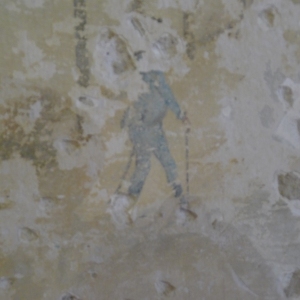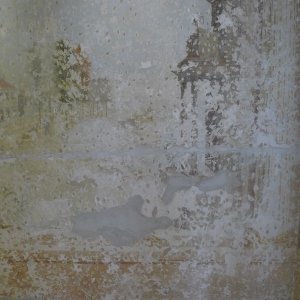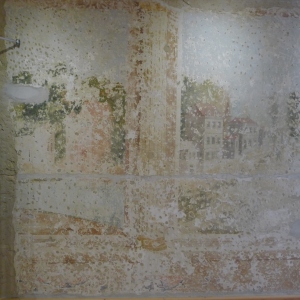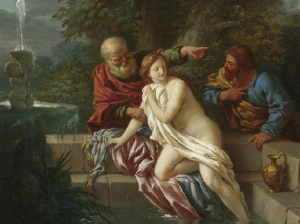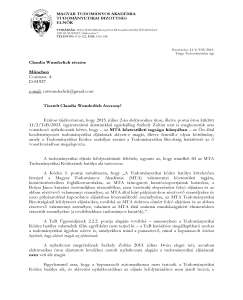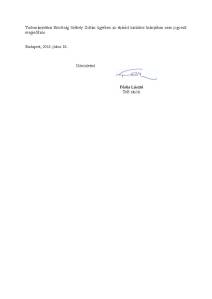Alajos Alois Unger as a frescoist?
It is a well-known fact that the Nazarenes earned great fame for their frescos in Villa Bartholdy and Casa Massimo in Rome in the 1810s/20s. One of these artists who participated in this work was Joseph von Führich (1800-1876), who became a professor of “historical composition” at the Vienna Academy of Fine Arts in 1840. Both he and his colleague Leopold Kupelwieser (1796-1862), Alajos Alois Unger’s main teacher, reestablished the fresco technique in Austria and taught it to their students. In Unger’s hometown Győr, a fresco from the first half of the 19th century, which looks as though it had been painted in the 1840s, by a hitherto unknown artist can be found in the so-called chapter house. It is owned by the diocese of Győr. On the upper floor of the house, an illusionist land- and townscape fresco can be found, which strongly resembles Unger’s picture clock in terms of style and colours. Further sources and/or technical art historical, investigation into the matter would be necessary and would through new light into the workings and influence of the late Nazarene and late Romanticist school onto Hungarian art in the 19th century as well as into the Kupelwieser-Führich circle’s activities in Hungary:
Zoligate — ZoliPlagWiki: Székely Zoltán, a győri Rómer Flóris Múzeum igazgatója, egy Guttenberg plágizátor utóda
Navigációs gyorslinkek, kattints:
Ki vagyok? Felvételek: Unger-kutatásom 2. videó: Plágium és csalás. Az események krónikája. E-Mail-krónika. ZoliPlagWiki és hibák. Hozzájárulásom a kiállításhoz. A múzeum sajtóközleménye. ZoliPlagWiki kronikája
(lászd is a továbbii részeket, iratokot és felvetteket itt blogomom) Székely Zoltán, a volt megyei múzeum igazgató helyetése és volt Hansági Múzeum és most a győri Rómer Flóris Múzeum igazgatója, nem akart megoldás, mint felajánltam, beszélgétesünkben pedig folytatta rabulistikus módon megsértni nekem. Sem hagyom magam megszarolni. Inkabb publikálom téljes, kommentált, e-mail korrespondenciánkat én. Összesen nem mint gondol ő, csak mutat, hogy nem jól tud nekem és hogy nem jól ért a német nyelvet. A levelezésem más emberekkel ezt mutat is. A fenti kép Zsuzsanna a fürdőben mutata további ok, hogy miért ilyen magaviselet. Azt mondják Székely Zoltánról, hogy, gondol, hogy mindig büntetelen marad.
Ha tiszta lelkiismerete lenne Székely Zoltán, hogy miért sem beleegyzte az MTA-viszgalátba?
Unger Alajos és a győri Unger család
Mi történt?
1987 óta kutatom — részben családom és jó ismérőseim segítségével, kb. 2000 óta pedig egyre behatóbban– magyar elődeimet: a győri Unger játékkártyafestő- és művészcsaládot.
Azzal a legjobb szándékkal, hogy a győrieknek és az akkori Xántus János Múzeumnak segítsek egy Unger Alajos-gyűjteményt felépíteni, valamint a művész életét és munkásságát tovább kutatni és dokumentálni, 2009 szeptemberében beleegyeztem, hogy cikket írok az Arrabona Évkönyvbe. Székely Zoltán kért meg erre, mivel 2010 szeptemberében és októberében kiállítást rendeztek a múzeumban, és többek között a családról írtam dolgozatomat az Oxfordi Egyetemen. Ez teljesen normális eljárásnak hangzott, azonban később olyasmi történt, amit senki nem képzelt volna:
– Zoltán Székely azt ígérte nekem, hogy a cikket a múzeum lefordítja magyarra, és 2010-ben megjelenteti az Arrabonában. A magyar nyelvű közzététel számomra nagyon fontos volt. Végül csak németül adták ki, bár egy barátunk a cikket szívességből lefordította. -> Szívességből vállalt munkám egyetlen elismerésével kapcsolatban becsaptak. Amint a múzeum hivatalos sajtóközleményében tudtul adta, cikkem és munkám nélkül a kiállításra nem kerülhetett volna sor!
– Az Unger-kiállítás megnyitójára a múzeum szónokként Dr. Szakál Gyula egyetemi docenst hívta meg, aki mindaddig nem foglakozott az Ungerek kutatásával. Beszédében többször idézett kiadatlan cikkemből, amelyet Székely Zoltántól tudomásom nélkül kapott meg. Ez tudományosan nem elfogadható eljárás, és plágiumot képez! Székely Zoltán hűtlenül kezelte a munkámat!
– A kiállításon használati szerződéssel ellentétesen használtak családi képeket és nem idézték a férjem (Prof. Dr.-Ing. Jürgen Wunderlich) történelmi játékkártyagyártással kapcsolatos munkáját. Székely Zoltán strukturális plágiumot követett el a férjem ellen. Egy kiállítási tábla úgy néz ki, mintha az utolsó percben vette volna át a férjem által készített műhelyvázlatot, de ami megmaradt, ennek ellenére strukturális plágiumot képez.
– Székely Zoltán a kiállításon és a sajtóközleményben azt a lényeges információt eltitkolta, hogy nemcsak általában Unger Alajos családját, hanem az olajfestményt és bécsi akadémiai tanulmányait is részletesen kutattam.
– Székely Zoltán ismételten szándékosan visszatartott Unger Alajosról és műveiről szóló információkat, akkor is, amikor kifejezetten ezeket kértem tőle (pl. a rajzok eredetijét nem mutatta meg és a családi portré hátoldalán levő pontos származási adatokat érdeklődésemre csak részben közölte. Rendelkezésemre áll egy fotó a kép hátoldaláról. Elhallgatta előlem az Unger családra való utalást, azt állítva, hogy nem tudja, ki az előző tulajdonos, noha Kieselbach műgyűjtőjegyzékében szerepel a név).
– Bár annyit dolgoztam szívességből és anyagilag is hozzájárultam a kiállításhoz, Székely Zoltán súlyosan megsértett, azt állította, hogy tudományos módszereim kétesek, és teljesen elfogadhatatlan módon kezelt engem.
– Végül Székely Zoltán az Arrabona 49/1 számában maga tett közzé egy Unger Alajosról szóló cikket. Azt, hogy tanulmányrajzait leírta, alapjában véve kifejezetten örvendetesnek tartom. Azonban cikkében nem teljesen és nem helyesen idézett. Minden idézetet kihagyott, amely azt mutatja, hogy a művészt és munkásságát már régóta kutatom és sok új felismerésre jutottam tevékenységéről!
A közös kiadványt előzőleg elutasította.
– Már tisztázó beszélgetésre se volt hajlandó velem, hogy világossá váljon, mennyiben súlyosbították a helyzetet a nyelvi-kulturális félreértések.
– Ezenfelül Székely Zoltán mind a kiállításon, mind a cikkében sok súlyos szakmai hibát követett el: még arra se volt képes, hogy a művész keresztelési dátumát pontosan lemásolja, és nem vette észre, hogy a kiállításon először bemutatott Madonna-kép Cesare da Sesto La vierge au bas-relief c. festményének másolata (ezt a képet 2010-ben “a legfontosabb kiállított tárgynak, Unger Alajos legkvalitásosabb munkájának” nevezte!). A hibák részletes bemutatása itt és itt is.
Összegzés: Székely Zoltán úgy próbálja meg beállítani, hogy művészettörténeti szempontból mindent ő kutatott fel, én pedig csak egypár családfakutatási adattal járultam hozzá. Ez viszont egyáltalán nem igaz!
Az én forrásjegyzékemmel járta a győri levéltárakat, azonban nem talált újabb ismereteket.
Amit bizonyíthatóan én találtam elsőként Unger Alajosról és munkásságáról:
– helyes keresztelési és halálozási dátuma (családom segíségével nyomoztam ki)
– a halál oka
– idősebb és ifjabb Unger Mátyás játékkártyafestők fia és fivére volt és nagyon valószínű, hogy maga is játékkártyafestő lett
– azok az idők, amelyekről bizonyítékkal rendelkezünk, amikor Hieronymi Ottó tanítványa is volt a győri rajziskolában
– hogy a bencés gimnáziumba is járt
– hogy nem csak 1836-tól tanult a bécsi akadémián, hanem első ízben már 1833-ban beiratkozott
– hogy az elemi rajziskolába, valamint aztán “Zeichnen bei den Antiken” Leopold Kupelwieserhez járt és Anton Schallernél mint tanárnál tett anatómiavizsgát.
– hogy a híres, Győrben is működő Toskano polgári kéményseprő-dinasztiánál lakott Bécsben
– olajművének rekonstruckciója és műlista (ezeket itt a blogomban dokumentáltam)
– hogy műve vallásos-romantikus, vagyis nazarénus jelleget visel, noha a portréfestészeten kívül a zsánerképfestészetet is művelte.
– pontosan mi a nazarénusi hagyomány a munkájában
– a Magyar Nemzeti Galéria tulajdonában levő családi portrén ábrázolt személyek leírása
– a Szent Család képének, valamint egy biedermeier képórájának fellelése
– hogy ez a Madonna-kép Cesare da Sesto festményének másolata
– újonnan fellelt olajművének leírása
– a család lakóházai, köztük Unger Alajos szülőháza, és az a ház, ahol meghalt
– a képek eredete
Közben a művet még sokkal részletesebben kutattam, magyar, osztrák és német levéltárakban és könyvtárakban, azonkívül a szegedi egyetemen egy konferencián beszéltem!
Mit kutatott fel Székely Zoltán?
Az Arrabona-cikk újdonsága az antik gipsznyomatok alapján készült tanulmányrajzok leírása szekunder irodalom segítségével. Az Arrabona 49/1 számának Unger Alajosról szóló cikkén kívül Székely Zoltán további közleményben: egy 1998-as kiállítási katalógusban írt Unger Alajos Unger csataképéről. Ez a rövid szöveg azonban nem tartalmazza az általa újonnan felkutatott eredményeket. Ott is a téves születési dátumot (1815) adja meg halálozási dátum nélkül. Ahogy egy győri barátunk kifejezte: Még arra sem vette a fáradságot, hogy a szomszédos városi levéltárban kikeresse a pontos születési dátumot!
Szakmai hibák
a) A kiállításon:
– a művész keresztelési dátuma: Unger Alajost 1814 október 29-én, nem pedig szeptemberben keresztelték.
– A Madonna-kép leírása teljesen hibás. A kép a valóságban Cesare da Sesto La vierge au bas-relief c. képének másolata, amelyet azonban Unger Alajos életében Leonardo da Vinci művének tartottak.
– Nincs Huber Maurer, csak Hubert Mauerer nevű festő, aki fontos festő volt az akadémián.
– Unger Alajos már 1833-ban a “helyes” akadémiára járt.
– Az Ungereknek nem ingaórájuk volt, mint a kiállításon, hanem Unger Alajos által festett biedermeier képórájuk.
– Idősebb Unger Mátyás elsősorban egyszerű, kedvező árú népi kártyákat gyártott, ez a kiállításon nem válik világossá.
– Hans Schäuffeleint jobb lenne nem Hans Leonhard Schäuffeleinnek nevezni, ezt egy művészettörténésznek tudnia kellene.
– A játékkártyagyártás folyamata ugyan a mi alapunkon készült, azonban bármi legyen is az oka, fontos lépések kimaradtak, ezáltal a bemutatás összességében hiányos, ellentmondásos; a szöveg nem veszi figyelembe az ábrákat, ezek sorrendje pedig teljesen logikátlan.
– A kiállításon bemutatott présgépet a kártyagyártásban másképp használták.
– A Madonna-képen kívül nem történik állásfoglalás a művek eredetére vonatkozóan (ezt egy Ukrajnában született, jelenleg Angliában élő művészeti szakértő kifogásolta, aki nagyon csodálkozott rajta).
– A doktori címemrről nem történik említés, és akkoriban Neu-Ulmban, nem pedig Neu-Kölnben dolgoztam.
b) – a cikkben:
– A keresztelés dátumát — ahogy már a kiállításon — téves (lásd fent)
– A család nem a mai Bástya utcában, hanem a mai Duna kapu téren lakott.
– egy kivétellel, Hubert Mauerer neve ismét többször Huber Mauerként fordul elő.
– Unger Alajos tanulmányainak idejét különösen az összefoglalásban hibásan áll: Unger Alajos 1833-tól folytatta tanulmányait (ennek kutatása céljából jártam a bécsi Akdaméiai Levéltárban, a megadott szekunder forrás, Fleischer téved ezen a ponton; ezért nehezen követhető, hogyhogy itt Fleischert (másodlagos forrás) idézi, ráadásul megjegyzés nélkül)
– fordítási hibák
– gyakran téves oldalszámok az idézeteknél, lásd plagizálás
– az 1998-as Kisalföldi Művészeti Lexikont idézi, nem a 2012-est, noha ott található az az aktualizált bejegyzés Unger Alajosról, amelyik engem idéz
Csak a források egy részét tudtam átvizsgálni, mivel a Bajor Állami Könyvtárban nem áll minden könyv rendelkezésre, ezért nagy valószínűséggel még több hibát lehet találni.
Unsolved family mysteries I — What happened to Géza Unger?
One of the hitherto unsolved mysteries in our family’s history is the fate of Géza (Viktor) Unger. Géza was my great-grandmother Ancs’ uncle, her father’s youngest brother born in Győr in 1860. Accoding to family lore, he deserted the army and emigrated to Nis, Serbia where he married a jeweller’s widow. Why exactly he deserted is unknown to us and it is surprising because his two older brothers Alajos and József (Pepi) both served in the army and his uncle, painter and draughtsman Alajos Unger, had served in the National Guard for a while. What backs this story are both an entrance in the town council minutes in his hometown from 1880, where it says that he was persecuted for an offence related to his military service in Budapest. Additionally there is a photograph by the Serbian photographer Milos Kostic in the possession of my family, which depicts what is probably a somewhat older Géza with a woman, most likely his wife. She might have been pregnant. Milos Kostic worked in Belgrade, but whether or not he also worked in Nis I have been unable to find out so far. Other than the photograph and the information passed down orally to us, we know nothing about how he fared, how long he lived, whether he did have offspring. The search is ongoing. Photos to follow in an update

